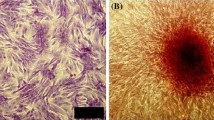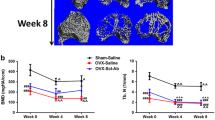Abstract
Recently, bioactive agents to stimulate bone formation have been available in the orthopedic field. We have shown previously that a single, local injection of basic fibroblast growth factor (bFGF) contributes to the formation of a larger cartilage (soft callus) but does not promote replacement of the cartilage by osseous tissue during experimental closed femoral fracture healing. Aiming at a clinical application, the present study was undertaken to clarify the effects of locally injected bFGF on bone (hard callus) formation and the mechanical properties of the callus in closed fracture healing in rats. Immediately after fracture, a carrier (200 μL of fibrin gel) containing 100 μg of bFGF or carrier alone was applied to the fracture site. At days 42 and 56 postfracture, the bone union rate, bone mineral density (BMD), and mechanical properties (strength and stiffness) of the callus were evaluated. Unexpectedly, with the exception of reduced stiffness in the FGF-injected callus at day 56, none of these parameters showed a significant difference between the control and the FGF-injected groups. Furthermore, the temporal expression pattern of OPN mRNA during healing was very similar between groups. We conclude that, in the healing of closed fractures of long bones, administration of bFGF forms a larger callus but does not necessarily accelerate the healing process.



Similar content being viewed by others
References
Rifkin DB, Moscatelli D (1989) Recent developments in the cell biology of basic fibroblast growth factor. J Cell Biol 109:1–6
Hurley MM, Abreu C, Gronowicz GA, Kawaguchi H, Lorenzo JA (1994) Expression and regulation of fibroblast growth factor mRNA levels in mouse osteoblastic MC3T3-E1 cells. J Biol Chem 269:9392–9396
Wroblewski J, Edwall-Arvidsson C (1995) Inhibitory effects of basic fibroblast growth factor on chondrocyte differentiation. J Bone Miner Res 10:735–742
Rodan SB, Wesolowski G, Yoon K, Rodan GA (1989) Opposing effects of fibroblast growth factor and pertussis toxin on alkaline phosphatase, osteopontin, osteocalcin, and type I collagen mRNA levels in ROS 17/2.8 cells. J Biol Chem 264:19934–19941
Kawaguchi H, Pilbeam CC, Gronowicz G, Abreu C, Fletcher BS, Herschman HR, Raisz LG, Hurley M (1995) Transcriptional induction of prostaglandin G/H synthase-2 by basic fibroblast growth factor. J Clin Invest 96:923–930
Shiang R, Thompson LM, Zhu YZ, Church DM, Fielder TJ, Bocian M, Winokur ST, Wasmuth JJ (1994) Mutations in the transmembrane domain of FGFR3 cause the most common genetic form of dwarfism, achondroplasia. Cell 78:335–342
Deng C, Wynshaw-Boris A, Zhou F, Kuo A, Leder P (1996) Fibroblast growth factor receptor 3 is a negative regulator of bone cell growth. Cell 84:911–921
Nakamura T, Hara Y, Tagawa M, Tamura M, Yuge T, Fukuda H, Nigi H (1998) Recombinant human basic fibroblast growth factor accelerates fracture healing by enhancing callus remodeling in experimental dog tibial fracture. J Bone Miner Res 13:942–949
Radomsky ML, Thompson AY, Spiro RC, Poser JW (1998) Potential role of fibroblast growth factor in enhancement of fracture healing. Clin Orthop 355:S283–293
Radomsky ML, Aufdemorte TB, Swain LD, Fox WC, Spiro RC, Poser JW (1999) Novel formulation of fibroblast growth factor-2 in a hyaluronan gel accelerates fracture healing in nonhuman primates. J Orthop Res 17:607–614
Kawaguchi H, Kurokawa T, Hanada K, Hiyama Y, Tamura M, Ogata E, Matsumoto T (1994) Stimulation of fracture repair by recombinant human basic fibroblast growth factor in normal and streptozotocin-diabetic rats. Endocrinology 135:774–781
Kawaguchi H, Nakamura K, Tabata Y, Ikeda Y, Aoyama I, Anzai J, Nakamura T, Hiyama Y, Tamura M (2001) Acceleration of fracture healing in nonhuman primates by fibroblast growth factor-2. J Clin Endocrinol Metab 86:875–880
Bland YS, Critchlow MA, Ashhurst DE (1995) Exogenous fibroblast growth factor-1 and -2 do not accelerate fracture healing in the rabbit. Acta Orthop Scand 66:543–548
Nakajima F, Ogasawara A, Goto K, Ninomiya Y, Moriya H, Einhorn TA, Yamazaki M (2001) Spatial and temporal gene expression in chondrogenesis during fracture healing and the effects of basic fibroblast growth factor. J Orthop Res 19:935–944
Bonnarens F, Einhorn TA (1984) Production of a standard closed fracture in laboratory animal bone. J Orthop Res 2:97–101
Nakajima A, Shimoji N, Shiomi K, Shimizu S, Moriya H, Einhorn TA, Yamazaki M (2002) Mechanisms for the enhancement of fracture healing in rats treated with intermittent low-dose human parathyroid hormone (1–34). J Bone Miner Res 17:2038–2047
Nakazawa T, Nakajima A, Shiomi K, Moriya H, Einhorn TA, Yamazaki M (2005) Effects of low-dose, intermittent treatment with recombinant human parathyroid hormone (1–34) on chondrogenesis in a model of experimental fracture healing. Bone 37:711–719
Yamazaki M, Nakajima F, Ogasawara A, Moriya H, Majeska RJ, Einhorn TA (1999) Spatial and temporal distribution of CD44 and osteopontin in fracture callus. J Bone Joint Surg Br 81:508–515
Jingushi S, Heydemann A, Kana SK, Macey LR, Bolander ME (1990) Acidic fibroblast growth factor (aFGF) injection stimulates cartilage enlargement and inhibits cartilage gene expression in rat fracture healing. J Orthop Res 8:364–371
Claes LE, Heigele CA, Neidlinger-Wilke C, Kaspar D, Seidl W, Margevicius KJ, Augat P (1998) Effects of mechanical factors on the fracture healing process. Clin Orthop Relat Res 355:S132–S147
Smith-Adaline EA, Volkman SK, Ignelzi MA Jr, Slade J, Platte S, Goldstein SA (2004) Mechanical environment alters tissue formation patterns during fracture repair. J Orthop Res 22:1079–1085
Acknowledgement
We are grateful to Kaken Pharmaceuticals for providing us with recombinant human bFGF. This study was supported by a Grant-in-Aid for Scientific Research from the Ministry of Education, Science and Culture of Japan.
Author information
Authors and Affiliations
Corresponding author
Rights and permissions
About this article
Cite this article
Nakajima, F., Nakajima, A., Ogasawara, A. et al. Effects of a Single Percutaneous Injection of Basic Fibroblast Growth Factor on the Healing of a Closed Femoral Shaft Fracture in the Rat. Calcif Tissue Int 81, 132–138 (2007). https://doi.org/10.1007/s00223-007-9048-7
Received:
Accepted:
Published:
Issue Date:
DOI: https://doi.org/10.1007/s00223-007-9048-7




